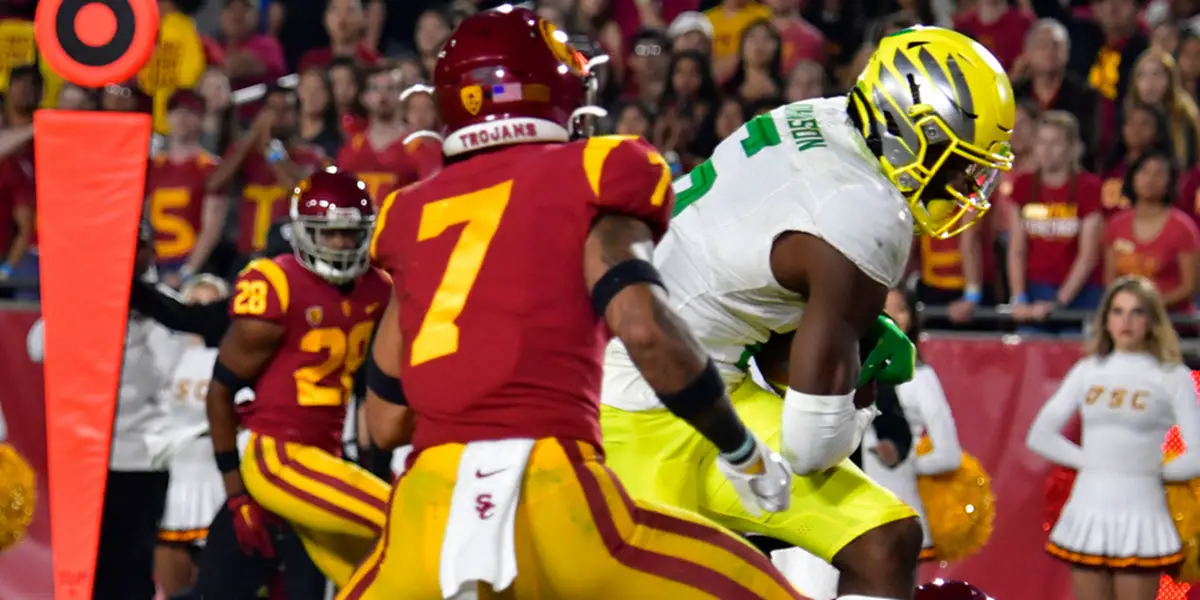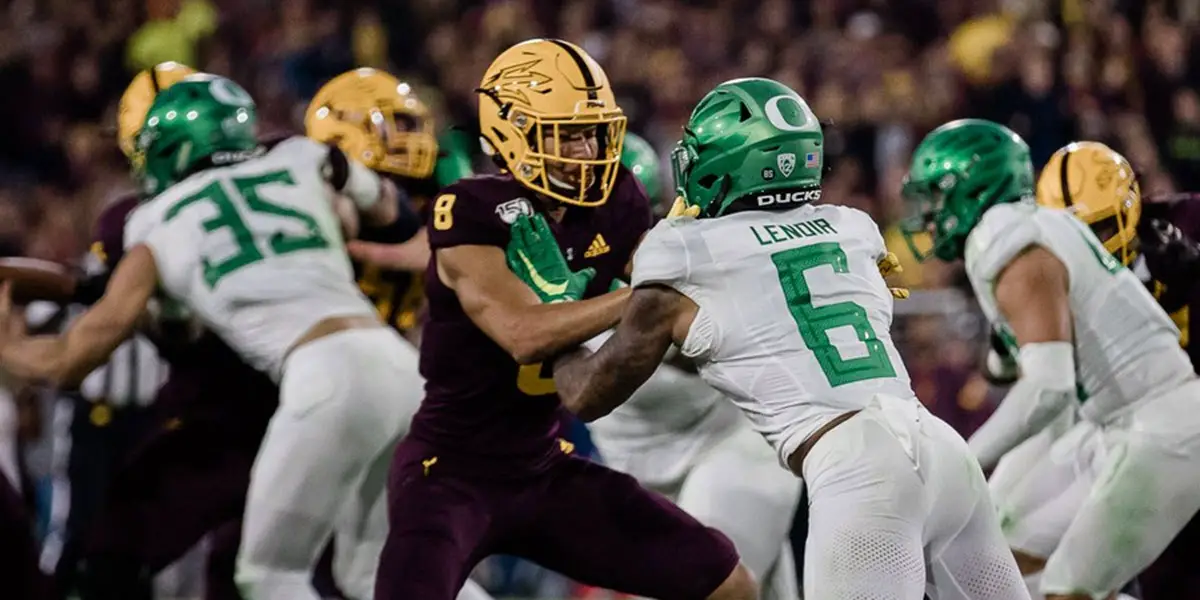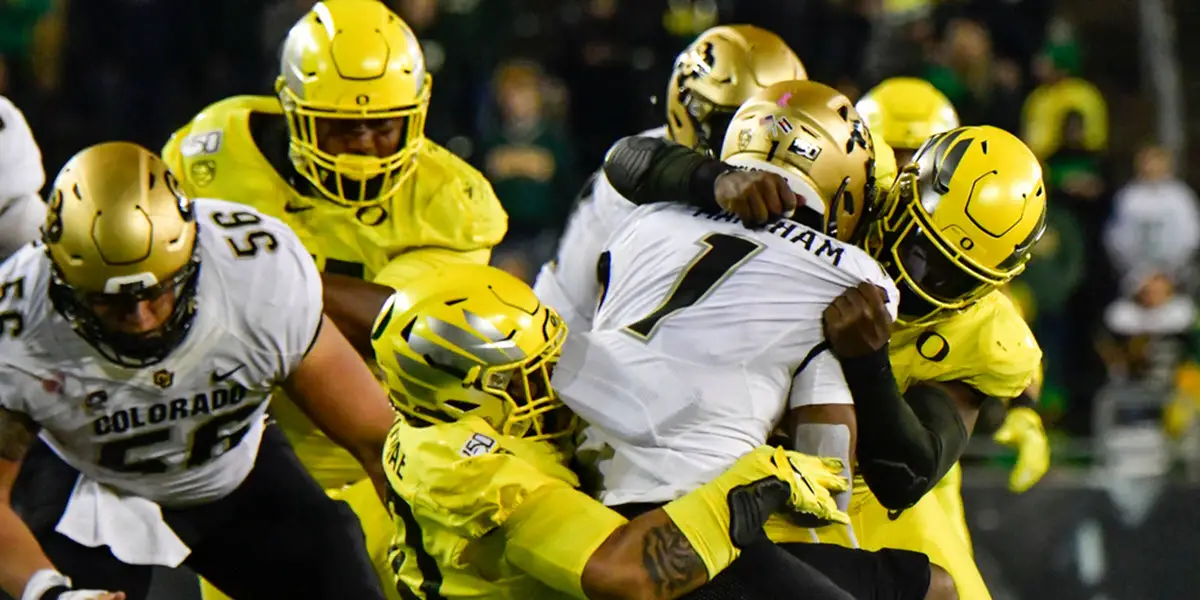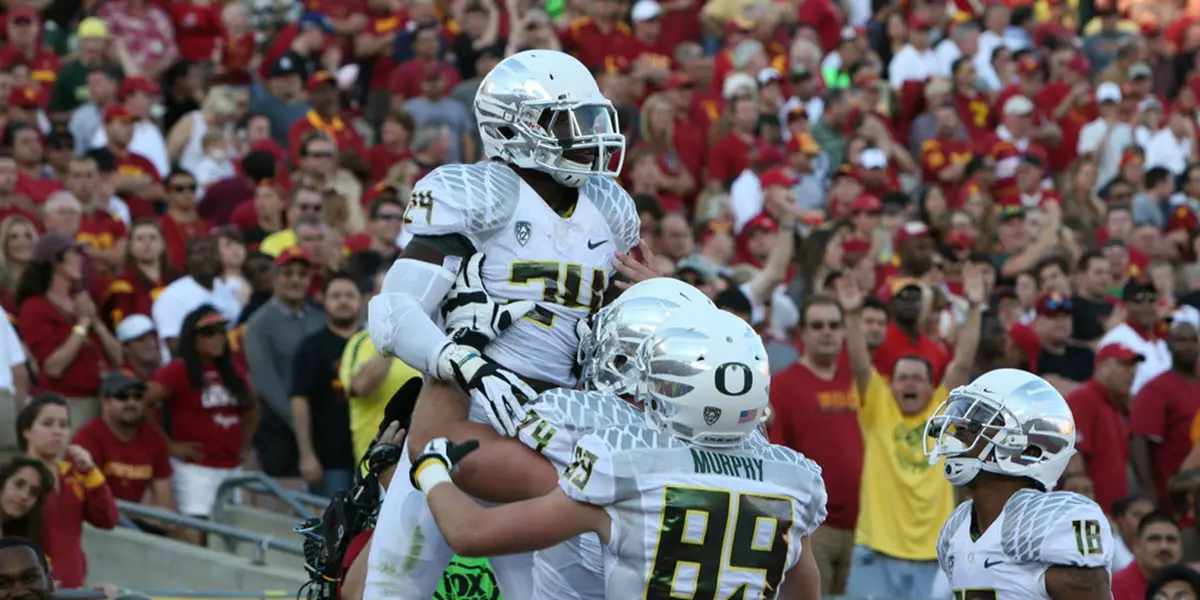Take a moment and think of this year’s conference schedule and pick out the top three games you want to see. As Oregon fans, Washington is going to be at the top of that list and Oregon State will always make the cut as these are both core rivalries. This year, that third spot is going to be held by USC, and arguably, most years that third spot is held by a California school.
From a financial standpoint, conference expansion makes a lot of sense. More teams in the conference means more markets to tap into, more advertising dollars and more money for all the teams involved. Four power five conferences have seen an expansion in the past decade, the Pac-12, Big-10, ACC and SEC. The only conference that hasn’t expanded over the past decade is the Big-12, which has lost members to the other conferences.
For Oregon fans, more has not meant better.

Juwan Johnson makes a catch against USC.
There is a reason for inner-conference rivalry. Going back to the Pacific Coast Conference, the first version of the PAC, which was established in 1915 and consisted of Oregon, Oregon State, Washington and California. Washington State would join in 1917, Stanford in 1918, USC in 1922 and then UCLA finally joined in 1928. Idaho and Montana were also members, but they would leave by the 1950s (and let’s be honest, no one misses them).
The Pac-8 would come into being in 1968 but would have the same core teams as the Pacific Coast Conference and those eight teams still make up the core of the Pac-12 today.
Football is a strange sport because of how few games are actually played in a given year. A typical regular season of college football is only twelve games, which means every single game has value, not just from a win-loss perspective but also from a fan experience. Inner-conference rivalries matter and in the case of the Pac-12, those rivalries stem from having a conference with some of the oldest core members in the country.
With the expansion into the Pac-12, the conference was split into north and south, which on the face of it, doesn’t sound too bad of an idea. Plus, there was special compensation made to ensure that all universities in California play each other yearly (Cal, Stanford, USC, and UCLA), which again, doesn’t sound bad on a surface level.

It won’t be until the 2021 season when Oregon gets to play against UCLA.
However, this has created some interesting scheduling for the rest of the conference as USC and UCLA have rigid scheduling requirements, meaning both schools miss out on two teams from the north every year.
In 1978, the Pac-8 would become the Pac-10 with the addition of the Arizona schools, who have worked their way into the PAC tapestry. Oregon fans all know how the desert brings sadness towards the end of the season and you have to look no further than this last year at Oregon’s loss at Arizona State.
However, even the inner-conference rivalries with the Arizona schools have taken a hit, though not as big of a hit as with the L.A. schools. Though a northern division team may play both Arizona teams in a season, there is also a possibility that a northern team plays neither!

Ducks fans know too well the dangers of the desert.
The addition of Utah and Colorado to the conference was something that us fans were told we wanted. More teams, more money, new rivalries, a new exciting conference championship game.. but in reality, we didn’t want these two teams.
Oregon has a history with both Utah (33 games played) and Colorado (22 games played). However, there is no rivalry between these teams.
Furthermore, the conference has tried to mush Utah and Colorado into their own rivalry, considering that as newcomers, they don’t have natural rivals in the conference. In joining the Pac-12, Utah and Colorado have had to schedule their traditional rivalries as out-of-conference games. This is not a unique circumstance as many teams have their in-state rivals in different conferences, just look at Florida and Florida State. Though, it does diminish the value of those rivalry games as a non-conference loss tends to have a smaller impact on a team’s season.
Since joining the Pac-12, Utah has become a respectable addition to the conference. They had a rocky start in their first three seasons in the Pac-12, which resulted in one winning season. However, after two back-to-back 5-7 seasons from 2012-2013, Utah has become respectable by the Pac-12’s currently low standards.

Oregon’s defense was too much for Colorado in a 45 to 3 victory.
Colorado, on the other hand, has been in a continuous fight to keep themselves out of the Pac-12 basement, having only made a bowl game once since joining the conference. Additionally, Colorado has only had one winning season of conference play. Both of these events were in 2016 when Colorado won the Pac-12 South and was the year Colorado beat Oregon for the first time since 1998.
As a fan, I cannot say that I get excited to play Utah or Colorado. Whereas, I circle the dates on my calendar for those games where Oregon matches up against a southern California foe.
I would rather Oregon play UCLA than Utah, even if Utah is the better team. In time, Utah and Colorado might become teams we love to hate. Until then, the loss of playing USC and UCLA yearly is something we will lament, as watching their respective fans filter out of the stadium early in the fourth quarter is truly one of the most precious sights in college football as an Oregon fan.
David Marsh
Portland, OR
Top Photo By: Kevin Cline

Chris Brouilette, the FishDuck.com Volunteer editor for this article, is a current student at the University of Oregon from Sterling, Illinois.
Related Articles:
Oregon Enters Playoffs Better Off Than Last Year
Will The Coaching Carousel Kill Oregon's CFP Chances?
The Playoff Formula Hasn't Changed
Oregon Aims to Bury Dawgs, Punch Playoff Ticket in Rivalry Clash
Huskies Are the New Beavers, Stay In Your Lane Kiffin, and the Civil Apple Cup War
Oregon Football: The X-Factor Vs. Washington

David Marsh is a high school social studies teacher in Portland, Oregon. As a teacher he is known for telling puns to his students who sometimes laugh out of sympathy, and being both eccentric about history and the Ducks.
David graduated from the University of Oregon in 2012 with Majors in: Medieval Studies, Religious Studies, and Geography. David began following Ducks Football after being in a car accident in 2012; finding football something new and exciting to learn about during this difficult time in his life. Now, he cannot see life without Oregon football.

